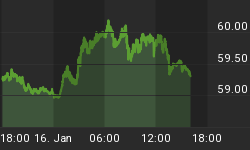After 8 months of indifference to the constant and persistent rise in stock prices, the "smart money" has finally turned bearish. It is time to pay attention.
The "Smart Money" indicator is shown in figure 1. The "smart money indicator is a composite of the following data: 1) public to specialist short ratio; 2) specialist short to total short ratio; 3) SP100 option traders. The "Smart Money" indicator is has turned bearish for the first time since January, 2009.
Figure 1. "Smart Money" Indicator/ weekly
The "Dumb Money" indicator (see figure 2) looks for extremes in the data from 4 different groups of investors who historically have been wrong on the market: 1) Investor Intelligence; 2) Market Vane; 3) American Association of Individual Investors; and 4) the put call ratio. The "Dumb Money" indicator is bullish to an extreme degree, and this implies that a price move is either nearing its end or the ascent of prices is surely to show. This is our expectation 85% of the time.
Figure 2. "Dumb Money" Indicator/ weekly
Figure 3 is a weekly chart of the S&P500 with the InsiderScore "entire market" value in the lower panel. From the InsiderScore weekly report we get the following: "early signals indicate that insiders are not going to deviate from the path they've taken over the past year".
Figure 3. InsiderScore/ weekly "entire market" value
Figure 4 is a weekly chart of the S&P500. The indicator in the lower panel measures all the assets in the Rydex bullish oriented equity funds divided by the sum of assets in the bullish oriented equity funds plus the assets in the bearish oriented equity funds. When the indicator is green, the value is low and there is fear in the market; this is where market bottoms are forged. When the indicator is red, there is complacency in the market. There are too many bulls and this is when market advances stall.
Currently, the value of the indicator is 67.14%. Values greater than 58% (arbitrarily chosen) are associated with market tops, and the red dots over the price bars indicate such.
Figure 4. Rydex Total Bull v. Total Bear/ weekly
Shorter term Rydex measures showed excessive bullishness (i.e, not seen since 2004) earlier in the week. This data, which has proved to be very actionable, is available as Premium Content. This service should help you improve your market timing.
















